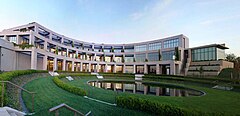National Audio-Visual Conservation Center
 |
|
 |
|
| Established | 2007 |
|---|---|
| Location | 19053 Mount Pony Road, Culpeper, VA |
| Coordinates | 38°26′31.052″N 77°58′25.539″W / 38.44195889°N 77.97376083°W |
| Website | www.loc.gov/avconservation/packard/ |
The National Audiovisual Conservation Center, also known as the Packard Campus for Audio-Visual Conservation, is the Library of Congress's new audiovisual archive located inside Mount Pony in Culpeper, Virginia.
From 1969 to 1988, the campus was a high-security storage facility operated by the Federal Reserve Board. With the approval of the United States Congress in 1997, it was purchased by the David and Lucile Packard Foundation from the Federal Reserve Bank of Richmond via a $5.5 million grant, done on behalf of the Library of Congress. With a further $150 million from the Packard Humanities Institute and $82.1 million from Congress, the facility was transformed into the National Audio-Visual Conservation Center, which completed construction in mid-2007, and after transfer of the bulk of archives, opened for scheduled tours and visitors in fall 2008. The campus offered, for the first time, a single site to store all 6.3 million pieces of the library's movie, television, and sound collection.
Technically, the Packard Campus (PCAVC) is just the largest part of the whole National Audio-Visual Conservation Center (NAVCC), which also consists of the Library of Congress's Motion Picture and Television Division and Recorded Sound Division reference centers on Capitol Hill, the Mary Pickford Theater, and any other Library of Congress audio-visual storage facilities that remain outside the Packard Campus.
The PCAVC design, named Best of 2007 by Mid-Atlantic Construction Magazine, involved upgrading the existing bunker and creating an entirely new, below-ground entry building that also includes a large screening room, office space and research facilities. Designers BAR Architects, project-architect SmithGroup and landscape designers SWA Group, along with DPR Construction, Inc., collaborated in what is now the largest green-roofed commercial facility in the eastern United States, blending into the surrounding environment and ecosystem.
...
Wikipedia
